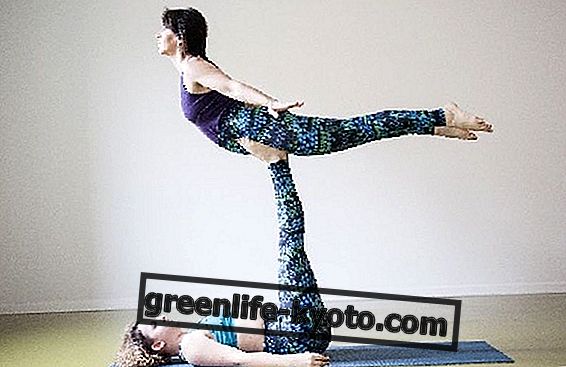
Let's deepen the theme of acroyoga with Paola Stropeni.
Always on the path of personal growth, Paola has undertaken various journeys to practice yoga, tantric and vipassana meditation, attending for several years experiential shamanism courses in close contact with nature .
Today she is a teacher of yoga and meditation, also for children and pregnant women, graduated from Ananda Ashram in Milan and the Association for Yoga and Meditation from Rishikesh in India and from AcroYoga International and Acroyoga Montreal .
Today, through yoga, dance and acroyoga, he has discovered a wonderful way of working with the body in all its expressions, rediscovering the inner journey that leads to the soul : it can therefore be called a "traveler of the soul" and we asked her to be our guide, giving us a smattering of the basic practice of acroyoga .
Paola, what is acroyoga for you?
With acroyoga it was love at first sight! The lightning strike was taken in March 2013 at my first workshop with Jacopo Ceccarelli in Milan!
I had no idea there could be such a fun, playful practice that would bring out the reckless little girl inside me!
Acroyoga has become a great passion, a moment of sharing with others and a constant challenge; it is an opportunity to measure myself against my fears, with my desire to break the mold and to go beyond the mind and at the same time it is an opportunity to measure myself against each other, to listen and share.
I really like flying, expressing my body and its potential, remaining in the present moment where the mind somehow resets itself; feel light and free.
I also like to act as a base and experience the sense of responsibility towards others, the continuous contact remaining attentive and supportive to my flyer. I find it a nice way to get to know each other better, develop sensitivity and listen to one's body and partner's needs, but above all it is fun, it brings people together creating harmony and respect.
AcroYoga is based on the concept of "community" and in such an individualistic age, I find it is a great lesson to rediscover that dimension of circle, of play, of sharing and of important values such as friendship, respect, openness, simplicity, humility, sharing.
8 Acroyoga positions

Front Bird : The base has legs at 90 degrees, feet parallel to the flyer's pelvis that remains in the locust position, with the chest open and the legs active.

Back Bird : feet of the base parallel to the heels starting from the buttocks towards the lumbar area and parallel legs. The flyer will have its back arched, its arms at its sides and its head turned towards the head of the base.
Entry / exit from the ground : The flyer enters the position giving the back to the feet of the base: it hooks the ankles with the hands and is made to welcome from the base that as soon as in contact with its feet (parallel) on the buttocks (fingers arrive to the lumbar ), bend the knees slightly to then stretch the legs 90 degrees and to exit, the flyer will hang up on the ankles of the base, which will bend the knees slightly to return the feet of the flyer to the ground. The flyer in this movement will bring the chin to the chest protecting the neck and back.

Candle Stick : Base lying down with knees bent, legs parallel. Flyer has outstretched arms and hands resting on the thighs of the base: the arms are active and continue to press towards the thighs of the base. the shoulders of the flyer rest on the hands (like a spoon) of the base which has outstretched arms but not perfectly perpendicular because its action will be to push towards its legs.
The hands of the base serve to control the balance of the flyer. The flyer must hold the body in alignment with the pelvis above the shoulders, regardless of the position of the legs that can be straight, in stag, spread, etc.

High Fly Whale : Therapeutic position. The feet of the base are parallel on the shoulder blades of the flyer that will stretch the arms beyond the head and relax in the position while maintaining the active legs.
The base supports the flyer keeping the arms stretched which hook one or the two ankles and with the feet the back of the flyer. This time the legs and arms of the base are not perfectly perpendicular but slightly diagonally .

Reverse Shoulderstand (supported): Vertical on the reverse shoulders: the base has perpendicular, stretched arms and with the spoon hands holds the flyer on the shoulders, which is hooked to the ankles of the base (whose legs are straight and at 90 degrees) maintaining arms outstretched. the body held and well aligned.

Bat (therapeutic): Legs of the pike flyer (team ie thighs towards the pelvis), legs bent and soles of the feet in contact. With your hands attached to your feet, arms extended, back and neck relaxed. The base has legs stretched at 90 degrees, feet on the inguinal joints of the flyer and with the hands can perform small massages at the neck and at the shoulders of the flyer.

STRADDLE BAT (position of the bat with the legs apart): Here the flyer has legs spread apart but in a team that weigh down, keeping the back relaxed. The base has the legs stretched at 90 degrees with the feet the inguinal joint of the flyer, points towards the inside.

Bow : From the front bird position the flyer bends the knees and with the hands hooks the ankles remaining with the shoulders open. The base will allow this movement giving some tiptoe. Everything happens slowly.
Contacts of Paola Stropeni
Website : www.paolastropeni-purnapremayoga.com
Facebook: Yoga & love
Instagram: Paola Stropeni
In the photos: woman base, Monica Abruzzi - man base, Francesco Semino - Paola Stropeni flyer













